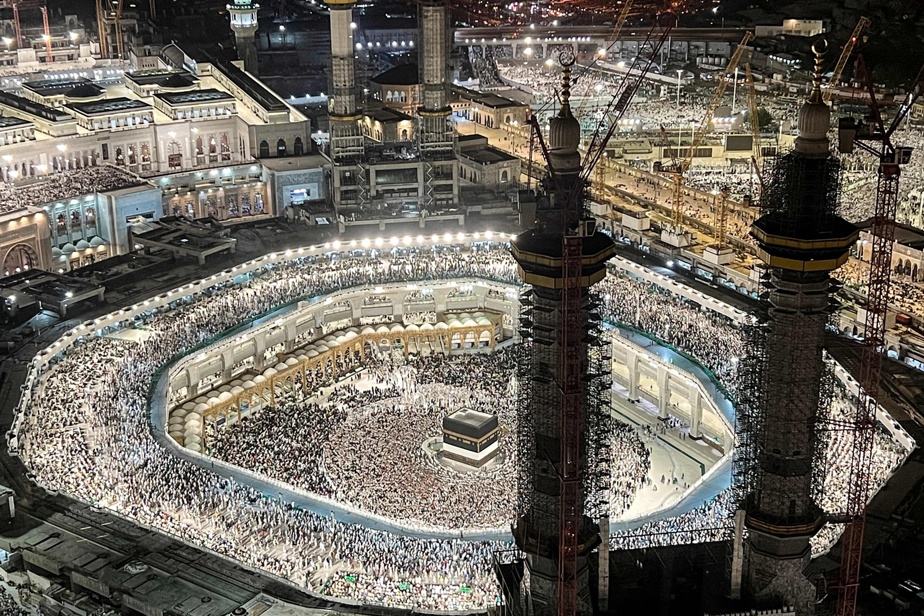(Mecca) Muslim worshipers flock to Saudi Arabia for the great pilgrimage to Mecca, the hajj, which will officially begin on Sunday with more than two million participants, the same number as before the COVID-19 pandemic and its drastic health restrictions .
One of the five pillars of Islam, the hajj must be performed at least once in the life of a practicing Muslim who can afford it. But since 2020 and the global health crisis, Saudi authorities had limited the number of visitors, gradually raising the quota to almost a million last year.
Birthplace of Islam, the wealthy Gulf monarchy, which is home to the most sacred places of this religion, this year lifted health restrictions on the number and age of pilgrims, who must however be vaccinated.
“More than two million pilgrims will come from more than 160 countries […] for the largest Muslim gathering in history,” said Saudi Minister for Pilgrimages, Tawfiq Al-Rabiah, in a video posted on Twitter.
In 2019, before the pandemic, around 2.5 million Muslims participated in the hajj.
Already nearly 1.5 million worshipers have arrived in Saudi Arabia for the hajj, not counting those who come from the interior of the country, authorities announced on Friday.

PHOTO SAJJAD HUSSAIN, AGENCE FRANCE-PRESSE
Tents housing pilgrims have been pitched in Mina, near the holy city of Mecca.
In recent months, the Gulf kingdom has already welcomed without restrictions the faithful coming to perform the umrah, or the “small pilgrimage” to Mecca, which can be carried out throughout the year.
For the annual hajj, the streets of the holy city are already packed, with the men mostly wearing the ihram, two layers of white cloth wrapping the body.
Souad Benouïss, a 60-year-old Moroccan, says she experiences “a strange feeling that mixes a lot of emotions”. “It’s the first time I’ve done the hajj after all these years. May God make it easy for us! “, she told AFP.
Logistics “challenge”
After oil, religious tourism remains an essential source of income for Saudi Arabia. Before the pandemic, hajj and umrah brought in about $12 billion a year.
More and more concerned with diversifying its economy, which is too dependent on black gold, the extremely wealthy monarchy sees bigger, and hopes to welcome 30 million pilgrims by 2030.
For Riyadh, it is also “an important source of prestige in the Muslim world”, notes Umar Karim, specialist in Saudi Arabia at the University of Birmingham, in the United Kingdom.
But the hajj, one of the largest religious gatherings, also represents a logistical “challenge” “ranging from crowd management to health checks, including the establishment of adequate accommodation for such a massive influx”, underlines the researcher at AFP.

PHOTO AMR NABIL, ASSOCIATED PRESS
View of the Kaaba at the heart of the Grand Mosque in Makkah
Many dramas, including deadly stampedes, have marked the history of the hajj. But no major accident has been recorded since 2015.
As high temperatures in one of the hottest regions in the world pose a growing challenge, authorities have installed numerous health structures and deployed 32,000 paramedics.
The government has also had, over the years, to develop infrastructure and make the passage of pilgrims more fluid.
“Road to Mecca”
Coming out of a plane, worshipers are taken by coach from the tarmac directly to their hotels, where they will receive their luggage. They benefit from the “Makkah Route” (the road to Mecca) initiative, launched in 2019.
It allows pilgrims to “regulate all the procedures related to luggage, health and visas in the country of departure”, explains to AFP Lieutenant-General Souleïmane Al-Yahia, in charge of this file at the Ministry of Interior.
According to him, “when the pilgrim gets on the plane, it is as if he were taking a domestic flight”.
The initiative, he said, includes seven countries: Bangladesh, Côte d’Ivoire, Indonesia, Malaysia, Morocco, Pakistan and Turkey.
Compared to his previous more complicated experience in 2017, Taher, who came from Bangladesh and who did not wish to give his last name, is delighted that “everything went well”.
At the heart of Mecca’s Grand Mosque, many pilgrims began convolutions around the Kaaba, a black cubic structure to which Muslims around the world turn to pray.
On Monday, they will travel to Mina, about five kilometers from the Grand Mosque, before climbing Mount Arafat the next day.
